Dark feminine art embraces shadow work through self-portraiture, gothic floral imagery, and powerful goddess archetypes like Kali and Lilith. Artists use deep blacks, blood reds, and midnight purples to express hidden emotions and feminine strength. Mixed media compositions featuring mirrors, bones, and thorns create altar-like displays celebrating feminine complexity. The femme fatale aesthetic challenges gender norms, while Victorian Gothic elements blend vulnerability with unexpected power. These 12 ideas reveal the mysterious beauty found in feminine darkness.
Key Takeaways
- Shadow work techniques using deep color palettes of blacks, reds, and purples reveal feminine emotional depth through self-portraiture.
- Mixed media assemblages featuring mirrors, bones, and dried flowers honor dark goddess archetypes like Kali and Lilith.
- Moody botanical compositions with thorny roses, night-blooming flowers, and moon phases symbolize feminine duality and mystery.
- Femme fatale imagery pairs beauty with danger through contrasting elements and enigmatic expressions that challenge traditional gender roles.
- Victorian Gothic-inspired female characters blend vulnerability with unexpected strength, creating powerful narratives of authentic feminine experience.
Shadow Work Through Self-Portraiture
How does one truly confront the shadows lurking beneath their surface? Through the powerful medium of self-portraiture, artists can immerse themselves in the mysterious depths of dark feminine energy.
The journey inward reveals our darkest shadows, where true feminine power awaits those brave enough to look.
This artistic journey invites women to capture themselves in moments of raw vulnerability, embracing both their light and darkness.
When engaging in shadow work, a photographer or painter turns the lens inward, creating moody, dramatic self-portraits that speak volumes about their hidden emotions.
These images, often bathed in shadows and contrasting light, reveal the parts of ourselves we typically hide from the world.
It’s like having a conversation with your reflection that goes beyond the surface!
Embracing the Divine Feminine in Mythology
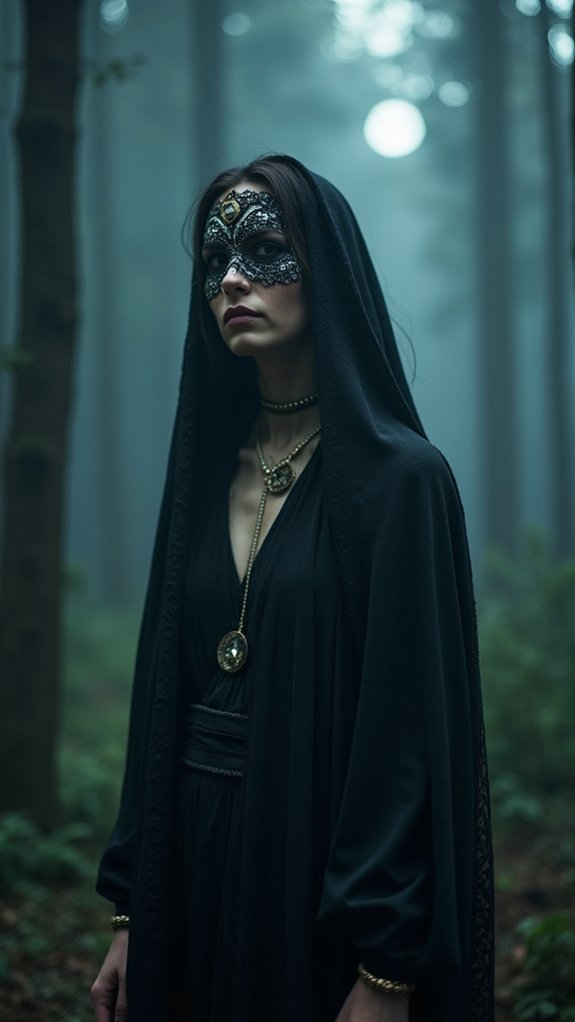
Mythology offers powerful examples of dark feminine energy through figures like Kali and Lilith who challenge simplistic notions of femininity.
Kali, with her necklace of skulls and blood-stained tongue, represents not just destruction but the necessary clearing away of ego and illusion that leads to spiritual awakening.
Lilith’s story as Adam’s first, rebellious wife who refused subservience shows how the divine feminine often includes elements of resistance, independence, and the courage to face exile rather than compromise one’s power.
Kali’s Wrathful Wisdom
Within the colorful tapestry of Hindu mythology stands Kali, a fierce goddess whose dark beauty and terrifying appearance have captivated artists for centuries.
With her multiple arms, necklace of skulls, and midnight-blue skin, she embodies the ultimate dark feminine aesthetic that goes way beyond the typical femme fatale. Kali’s wrathful wisdom teaches us something super important – that embracing our shadow side is actually healthy!
Artists love to show Kali in all her fierce glory because she represents the power of transformation.
She reminds us that sometimes we need to destroy old patterns before we can create something new. Her wild, untamed energy breaks all the rules about how women “should” behave, making her the perfect inspiration for art that explores the strength of feminine rage and the beauty found in life’s darker emotions.
Lilith’s Rebellious Divinity
Long before Eve bit into that famous apple, Lilith stood her ground as the original rebel of paradise.
Artists seeking to capture this Dark Feminine energy often depict her with flowing hair, mysterious eyes, and an untamed spirit that refuses to be controlled. Lilith’s story resonates in modern art as a powerful symbol of Empowerment for those who dare to live authentically.
To create Lilith-inspired artwork, consider portraying her emerging from shadows, surrounded by night creatures like owls and serpents. Her gaze should be both fierce and knowing, challenging viewers to recognize the strength in their own rebellion.
Use rich colors that blend darkness with flashes of vibrant life—deep purples, midnight blues, and blood reds that pulse with hidden power. After all, Lilith reminds us that sometimes walking away is the bravest choice of all.
Creating Moody Botanical Art With Feminine Symbols
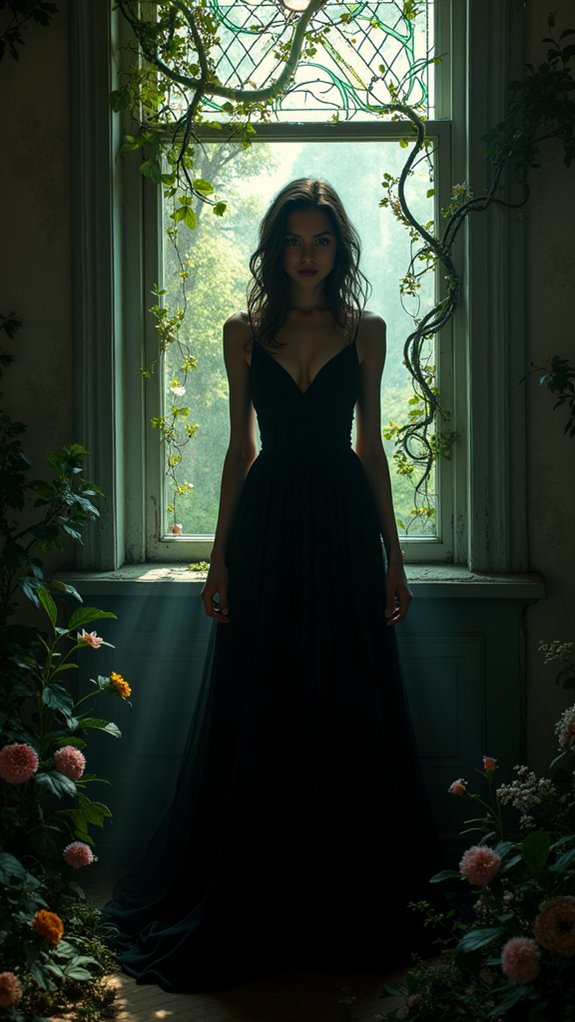
Artists seeking to express the mysterious side of femininity can transform ordinary botanical subjects into powerful statements through moody compositions.
By combining shadow garden watercolor techniques with symbolic florals like night-blooming jasmine or deadly nightshade, creators tap into the ancient language of plants that witches and healers have used for centuries.
These dark botanical pieces work best when they balance beauty with hints of danger, often incorporating lunar phases or serpent imagery to enhance their connection to feminine energy and power.
Symbolic Floral Composition Techniques
The haunting beauty of dark feminine floral art emerges when symbolic elements intertwine with botanical forms, creating visual stories that whisper secrets. When crafting Dark Feminine Art compositions, artists strategically layer thorns with delicate petals, mirroring the complex nature of feminine energy. These makeup-inspired floral arrangements often feature moon phases nestled among roses, creating mysterious makeup looks that transform botanical elements into powerful statements.
| Symbol | Meaning | Composition Technique |
|---|---|---|
| Moon | Mystery, intuition | Crescent shapes behind flowers |
| Roses | Beauty, passion | Center focus with thorny stems |
| Thorns | Protection, pain | Interwoven with delicate petals |
| Black flowers | Rebellion, power | Dramatic focal points |
| Purple blooms | Magic, wisdom | Scattered throughout for depth |
Shadow Garden Watercolor Methods
Dipping a brush into midnight-blue watercolor, shadow garden techniques transform ordinary botanical illustrations into enchanting realms of feminine mystery.
These moody compositions blend dark hues with vibrant elements, creating spaces where dramatic makeup inspiration and feminine power coexist in artistic harmony.
- Wet-on-wet application – Layer deep purples and blacks while still damp to create ethereal backgrounds that mimic twilight gardens.
- Symbolic integration – Add crescent moons, silhouettes, and flowering vines to tell stories of empowerment and mystery.
- Color contrast techniques – Juxtapose dark shadows against bright botanical elements for eye-catching Stock Photos quality results.
- Glazing methods – Apply transparent layers of watercolor to build depth and dimension, enhancing the mystical quality of your feminine garden scenes.
Mystical Plant Symbolism
Beneath moonlit skies, mystical plants whisper ancient secrets of feminine power, their twisted stems and velvety petals becoming more than mere botanical subjects.
Artists draw from botanical folklore when creating dark feminine art, incorporating night-blooming flowers like moonflowers that open only under darkness’s embrace. These sacred herbs and thorny roses weave stories of strength, mystery, and resilience.
Dark color palettes—deep emerald greens, inky blacks, and midnight blues—enhance the moody atmosphere essential to this artistic expression.
Many artists intertwine these plants with feminine rituals and goddess imagery, creating visual narratives that explore womanhood’s complex nature.
Just as Frida Kahlo used botanical elements to express her innermost emotions, contemporary artists can transform ordinary plants into powerful symbols that celebrate femininity’s shadowy, beautiful depths—where delicate blooms and protective thorns coexist perfectly.
The Femme Fatale: Capturing Seductive Strength
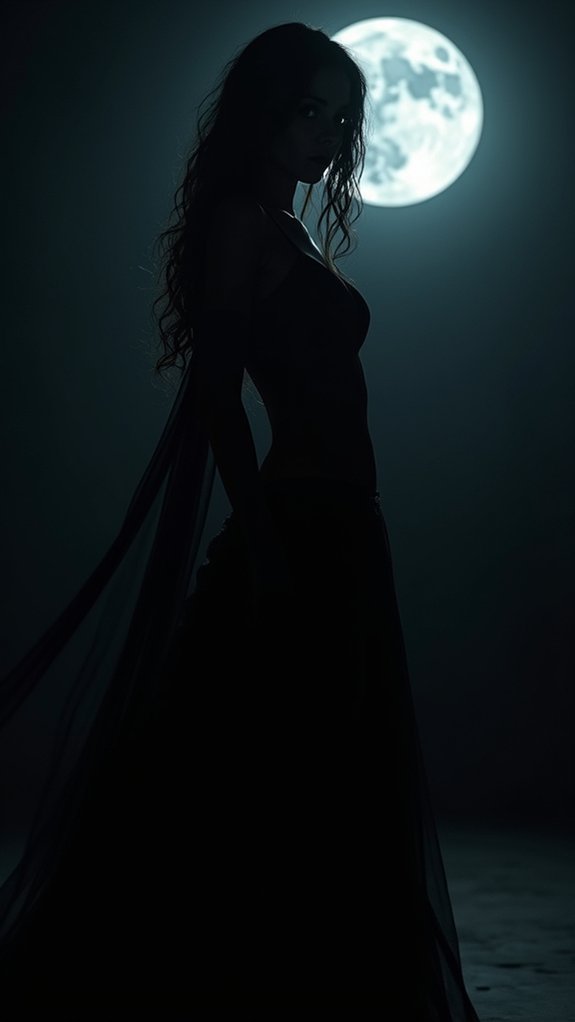
Throughout history, femme fatales have captivated audiences with their intoxicating blend of beauty and danger. The femme fatale archetype challenges traditional gender roles, embodying complex femininity that both attracts and threatens.
Artists like Cindy Sherman have explored this powerful duality through unsettling photography that critiques sexualized female roles.
Creating art inspired by seductive danger requires:
- Rich, moody color palettes – think deep reds, blacks, and purples
- Symbolic elements representing transformation – butterflies, moons, or snakes
- Contrasting imagery – pairing delicate flowers with thorns or weapons
- Mysterious expressions – half-hidden faces or enigmatic smiles
Film noir characters perfectly showcase this fascinating balance of allure and power. The femme fatale isn’t just scary-pretty – she’s a commentary on how femininity can be both nurturing and destructive, soft yet formidable.
Moon Cycle Imagery and Feminine Power
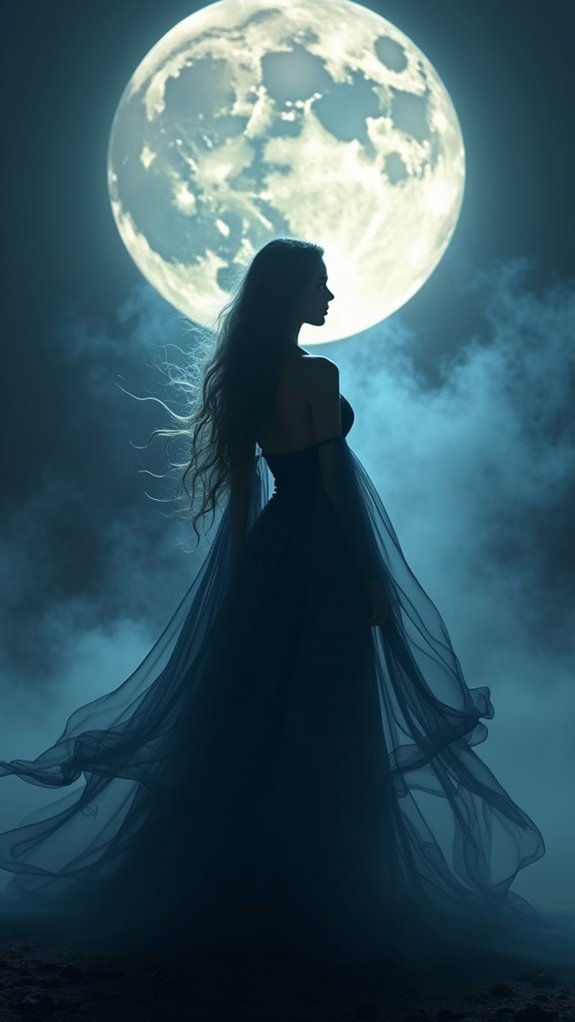
The moon’s ancient connection to feminine energy has inspired countless artists to explore its mysterious power and symbolism. In dark feminine art, moon phase symbolism creates a visual language that speaks to women’s inner transformations, mirroring the waxing and waning of personal strength.
Artists often depict the New Moon as a shadowy promise of rebirth, while the Full Moon bursts with radiant completion and self-knowledge.
Lunar energy exploration through art invites viewers to embrace their cyclical nature rather than resist it. Many creators use deep blues, silvers, and blacks to enhance this connection, sometimes portraying women physically transforming with the moon’s phases.
This feminine cycles representation reminds us that, like the moon, women’s power isn’t static—it ebbs and flows, gathering strength in darkness before revealing its full, illuminated glory.
Dark Goddess Archetypes in Mixed Media
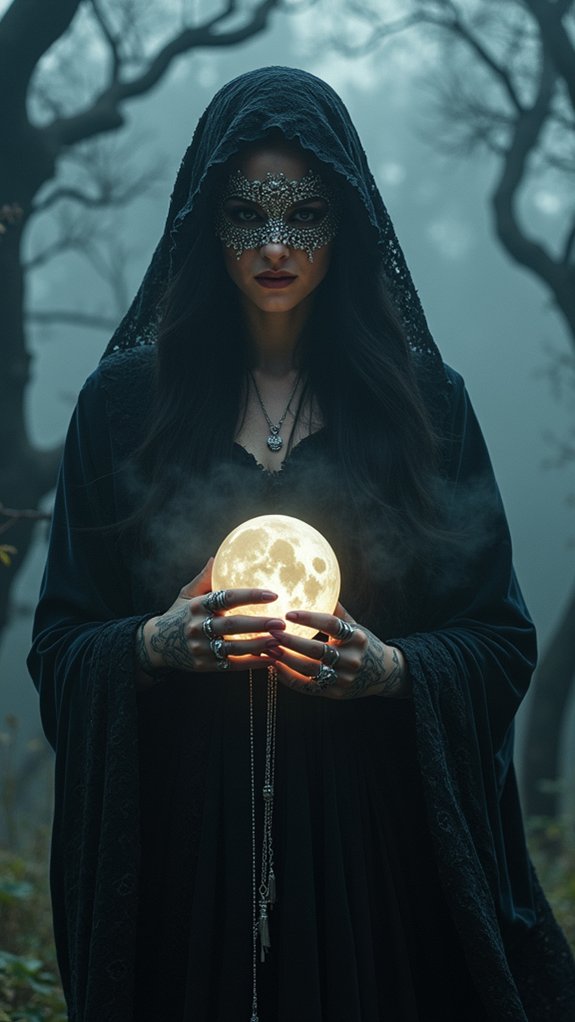
Mixed media artists exploring dark goddess archetypes often create altar-like compositions that honor the shadow aspects of femininity.
These ritual-inspired arrangements might include objects like mirrors, bones, or dried flowers, arranged in ways that feel both sacred and slightly unsettling.
Confronting Shadow Aspects
Diving into the depths of feminine identity, artists harness dark goddess archetypes in mixed media to confront shadow aspects that society often avoids. Through shadow integration techniques, creators weave together contrasting materials that mirror the complexity of feminine experience, transforming pain into power.
- Incorporating dark lace with bold colors to represent the duality within feminine rage expression.
- Combining found objects with paint to create tactile experiences that invite viewers to touch the forbidden.
- Using fabric scraps and industrial elements to symbolize the tearing down and rebuilding of feminine identity.
- Layering transparent materials over opaque bases to reveal what lies beneath surface appearances.
Reclaiming darkness becomes an act of liberation, as artists like Kahlo and Horn have shown. Their work celebrates the whole woman—shadows and all—inviting us to embrace our complete selves.
Ritualistic Altar Compositions
When ancient and modern worlds collide, ritualistic altar compositions emerge as powerful gateways to the divine feminine mysteries. These mixed media creations honor dark goddess archetypes through carefully arranged symbols—moons, serpents, and flowers—that tell stories of transformation and power.
Artists select altar materials with ritual significance: black velvet drapes contrast with glittering crystals, while flickering candles cast dancing shadows across textured surfaces.
Taking inspiration from figures like Lilith and Kali, these altars become personal explorations of the shadow self, inviting viewers to embrace their own hidden depths.
The beauty of these compositions lies in their layered approach—collage elements might overlap with painted details, while natural materials like feathers or bones remind us of our connection to cycles of death and rebirth.
Each altar becomes a unique doorway to feminine empowerment.
Victorian Gothic Female Characters
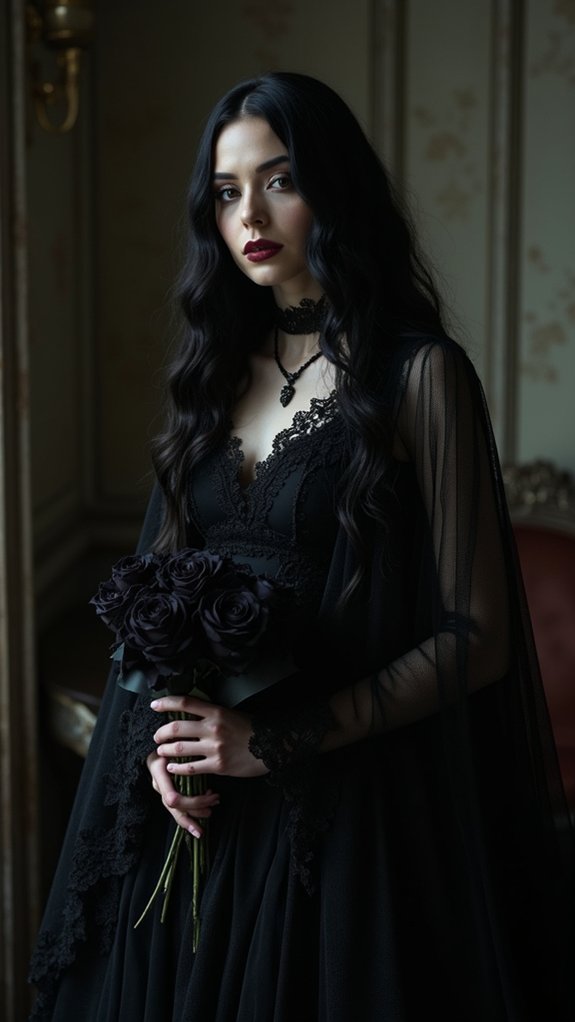
Throughout the shadowy corners of Victorian Gothic art, female characters emerge as enthralling figures wrapped in mystery and power. These dark feminine icons challenge traditional roles while enchanting audiences with their Gothic allure and complex nature.
- Victorian heroines like those in Mary Shelley’s works blend vulnerability with unexpected strength, making them relatable yet hauntingly mysterious.
- The visual aesthetic features flowing black dresses, lace details, and pale complexions against dark backgrounds, creating unforgettable silhouettes.
- Femme fatales of the period represent a fascinating duality – beautiful yet dangerous, loving yet deadly.
- These characters continue to inspire modern artists and fashion designers, who draw upon their dark femininity to create contemporary works that explore feminine power through a shadowy lens.
Tarot-Inspired Dark Feminine Illustrations
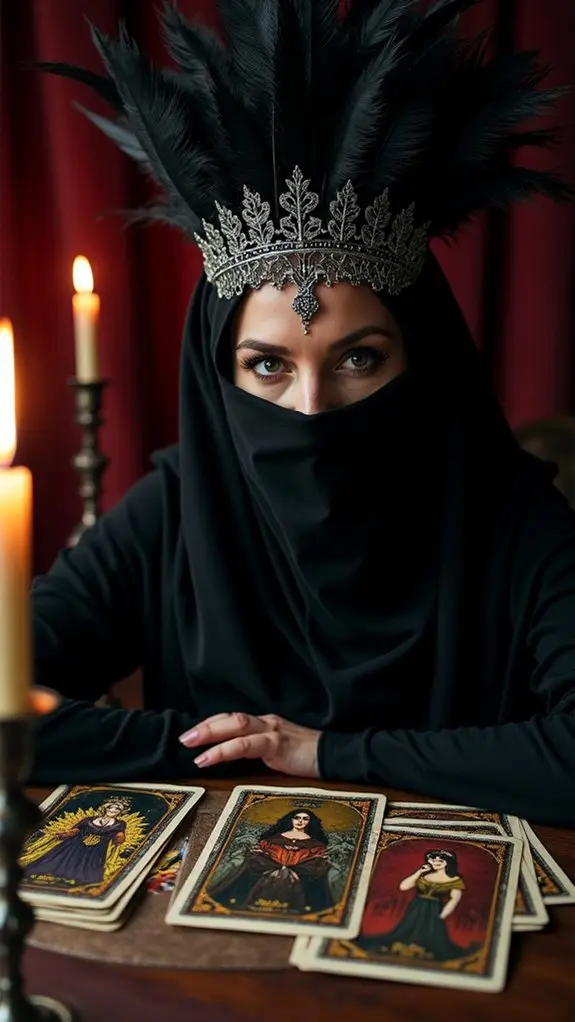
The mysterious allure of Victorian Gothic heroines finds a natural extension in the realm of Tarot-inspired dark feminine illustrations. These powerful images capture feminine archetypes like The High Priestess and The Empress, showcasing women as keepers of ancient wisdom and intuitive power.
Artists create these spellbinding works using deep, rich colors against shadowy backgrounds, where mystical symbolism speaks to viewers on a subconscious level. A woman might appear with ravens, crescent moons, or crystal balls—each element telling part of her story.
These illustrations aren’t just pretty pictures; they’re empowering narratives that invite us to explore our own inner darkness and light.
When we look at these magical tarot-inspired pieces, we’re connecting with thousands of years of feminine mystery and strength—reimagined for today’s world in deliciously dark detail.
Sensual Silhouettes and Negative Space
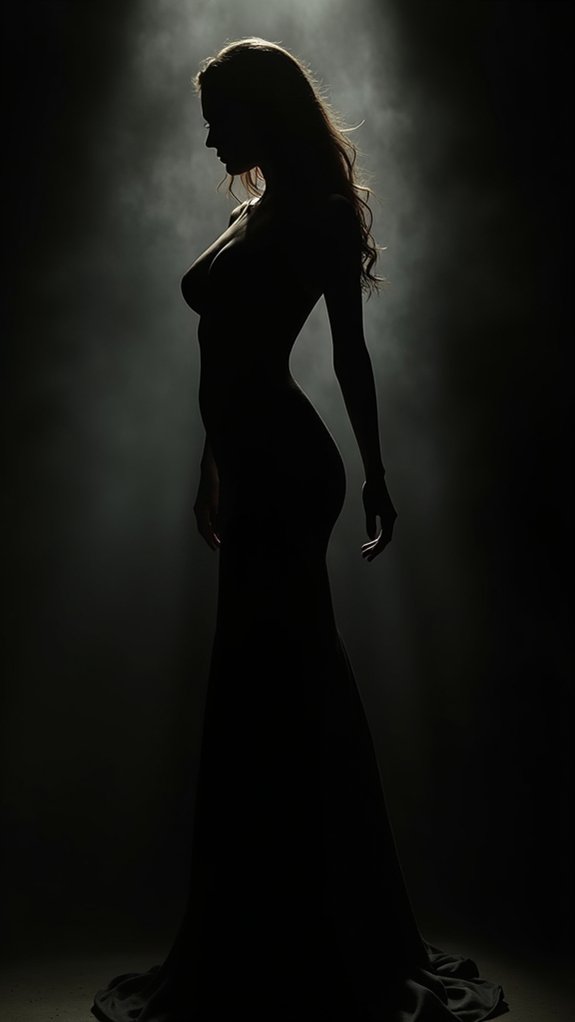
Shadows dance across the canvas in sensual silhouettes, revealing the powerful mystery of feminine forms without exposing their secrets. The art of feminine abstraction emerges from darkness, creating stories without words through the careful play of light against form.
- Silhouette storytelling captures the essence of femininity through contours alone, inviting viewers to complete the narrative with their own imagination.
- Artists use negative space to suggest presence, allowing the unseen to speak as loudly as what’s visible.
- Shadow emotions emerge when viewers connect with these mysterious forms, often feeling a mix of intrigue and recognition.
- The contrast between light and dark creates tension that mirrors the complexities of feminine identity—both vulnerable and strong.
This technique transforms simple outlines into powerful statements about womanhood, celebrating form without exploiting it.
Occult Symbolism and the Witch Aesthetic

Mystic energies flow through dark feminine art when the witch aesthetic takes center stage, blending ancient symbols with modern feminist power. Artists incorporate occult symbolism like pentacles, moons, and mystical creatures to create works that speak to hidden knowledge and feminine mysteries.
The witch, once feared, now represents feminine empowerment and rebellion against restrictive social norms. This powerful aesthetic often features deep, moody colors, flowing black fabrics, and nature elements like bones, herbs, and animal familiars.
Artists like Yoko Ono have transformed witch archetypes into celebrations of women’s wisdom and strength. Through ritualistic imagery, these artists connect viewers to the ancient tradition of witches as healers and wise women, reclaiming what was once used to persecute into something that radiates power and self-determination.
The Transformation of Beauty Through Decay
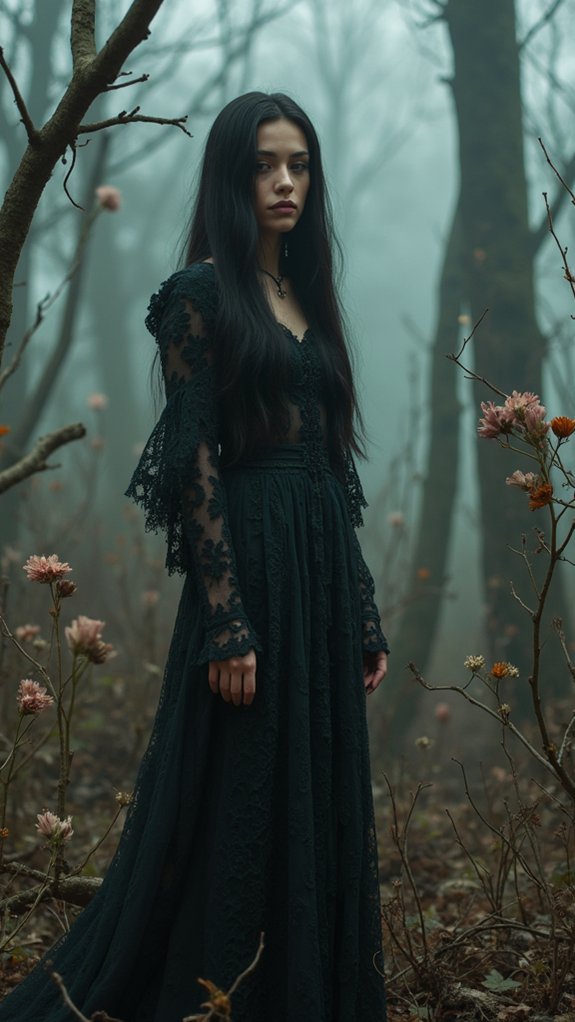
Beyond the mystical realm of witchcraft lies another powerful expression of dark feminine art — beauty discovered in decay and deterioration. This enchanting aesthetic embraces the natural cycle of life, celebrating both fragility and strength through decay symbolism.
Artists explore this theme through:
- Wilting flowers paired with vibrant elements, illustrating the beauty impermanence of feminine existence.
- Portraits showing transformation over time, where aging becomes a powerful narrative rather than something to fear.
- Mixed media works incorporating actual decaying materials, creating tangible connections to nature’s cycles.
- Self-portraits revealing personal struggles, inspired by Frida Kahlo’s resilience narratives.
The allure of decay in feminine art isn’t about glorifying destruction, but rather finding power in change.
When artists embrace imperfection, they celebrate the authentic journey of womanhood – complete with its challenges, transformations, and unexpected beauty.
Emotional Depth Through Dark Color Palettes
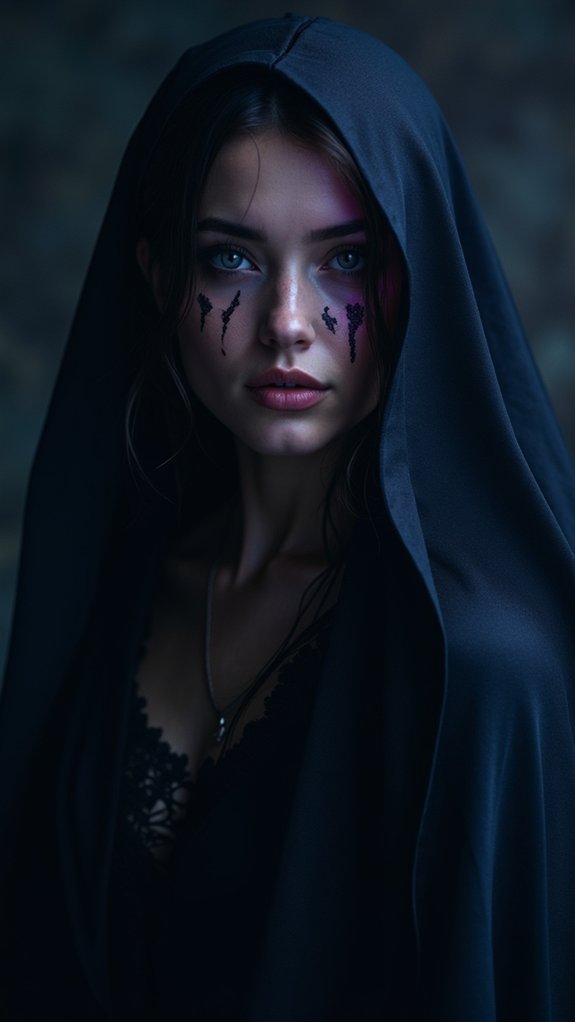
While light often dominates traditional artistic expressions of femininity, dark color palettes reveal deeper emotional territories that artists have embraced throughout history. Deep blacks, blood reds, and midnight purples create an emotional resonance that speaks directly to our hidden feelings, making viewers feel both uncomfortable and strangely connected.
Artists like Frida Kahlo brilliantly use color psychology to express feminine narratives that aren’t always pretty but are definitely powerful. When we see these dark-toned artworks, we’re invited into a secret world where feminine strength isn’t about being perfect—it’s about being real!
The shadows and contrasts in these pieces aren’t just artistic choices; they’re like visual diaries of women’s complex experiences. Through darkness, ironically, these artists shine the brightest light on what it means to be authentically feminine.
Frequently Asked Questions
How Do You Embody Dark Femininity?
One embodies dark femininity by embracing vulnerability while connecting with their Shadow Self, channeling its transformative power to reclaim autonomy, intuitive wisdom, and unapologetic self-expression beyond societal expectations.
What Is the Dark Feminine Archetype?
The dark feminine archetype embraces the Shadow Self within female identity, celebrating the Feminine Mystique through complexity and contradiction. It harnesses Empowering Darkness to reclaim suppressed aspects of womanhood beyond societal constraints.
How Do You Invoke Dark Feminine Energy?
Invoking dark feminine energy involves Shadow Work to embrace rejected aspects, Embracing Intuition through meditative practices, and Reclaiming Power by asserting boundaries. This transformation requires confronting societal conditioning and honoring primal feminine wisdom.
What Is the Divine Feminine Art?
Divine feminine art portrays sacred femininity through mystical symbols and goddess representations, celebrating the spiritual essence of womanhood. It expresses intuitive wisdom, creation, and nurturing energies across diverse artistic mediums.
Conclusion
Dark feminine art invites artists to explore the mysteries of womanhood through shadow and light. By embracing these twelve approaches, creators can tap into powerful emotions, ancient symbols, and the complex beauty of the feminine experience. Whether through moody botanicals or occult imagery, this art form celebrates the parts of femininity society often fears. In these shadows, artists find not darkness, but a different kind of illumination—one that empowers and transforms.


Leave a Reply